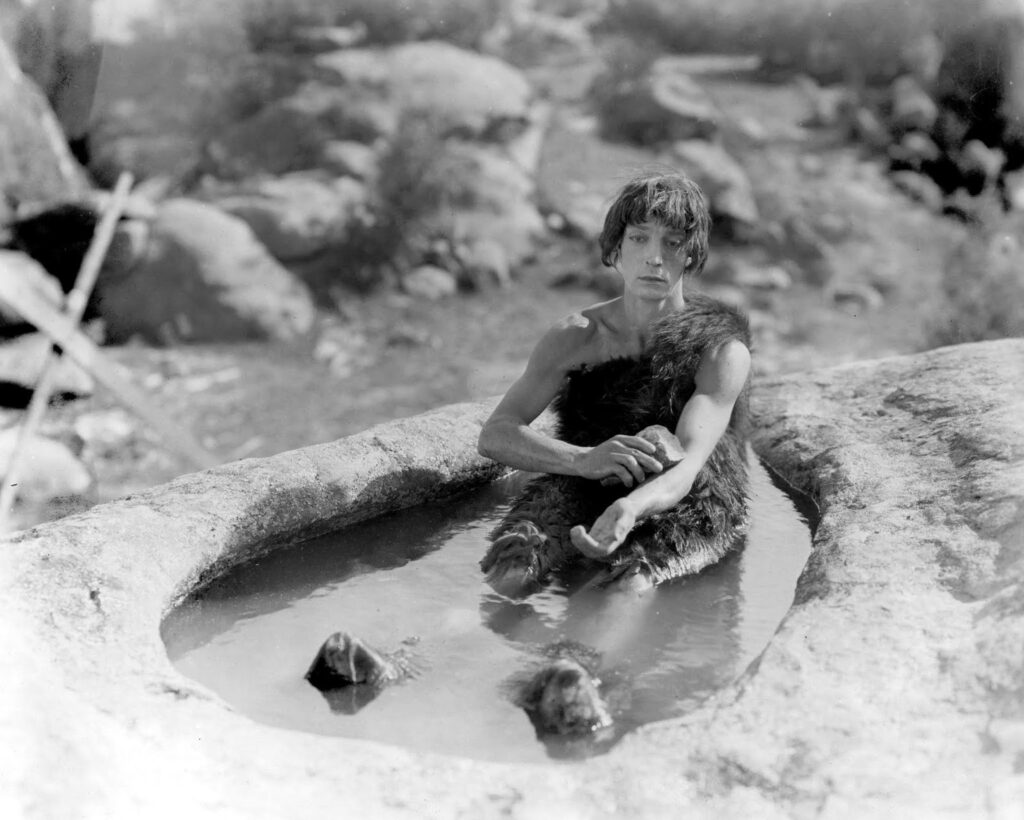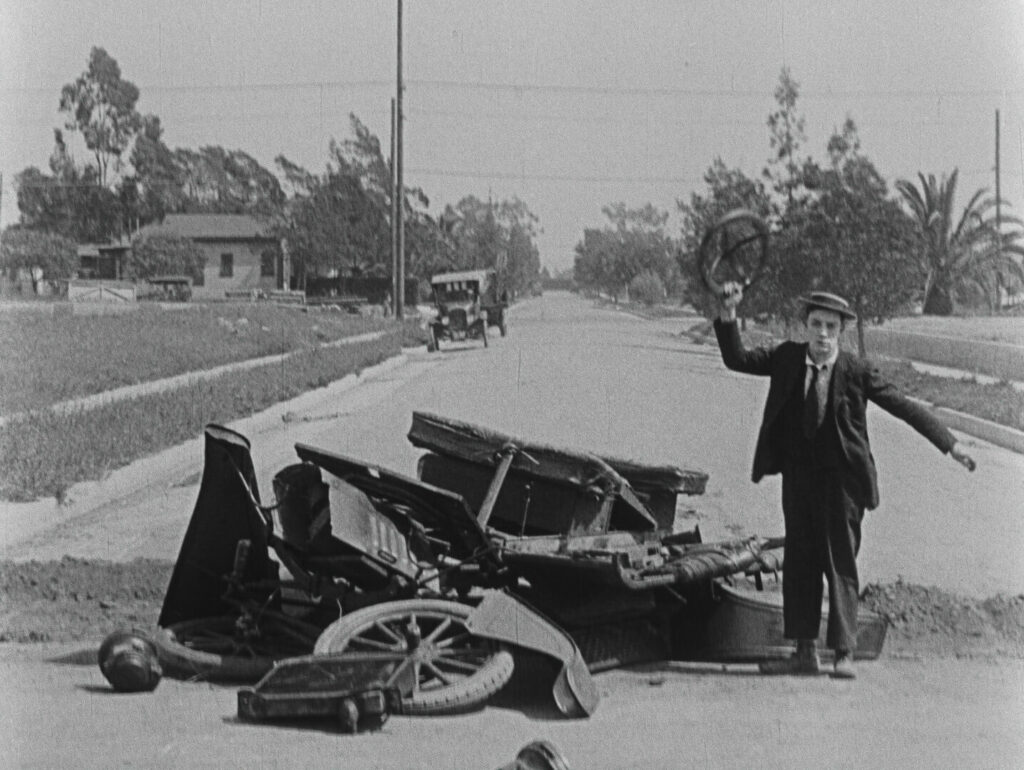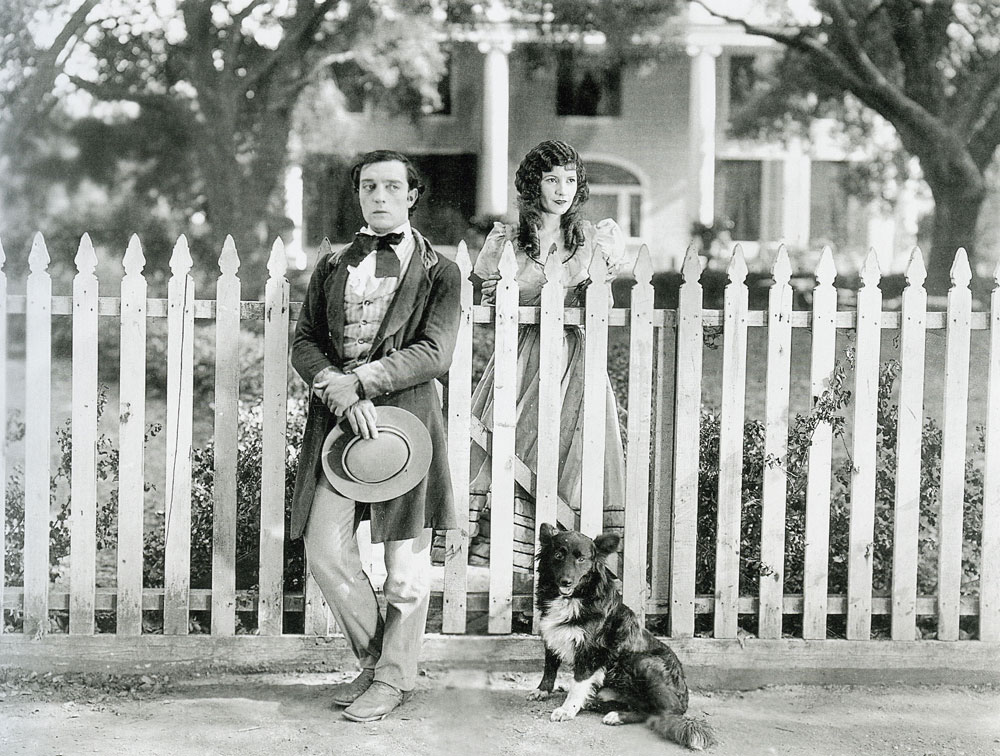Buster Keaton Shines Anew In Recent Restorations Of His First Two Directed Features
DIRECTORS: BUSTER KEATON & EDDIE CLINE (TA); BUSTER KEATON & JOHN BLYSTONE (OH)
STREET DATE: NOVEMBER 7TH, 2023/COHEN FILM COLLECTION & KINO LORBER

Recent restorations of Buster Keaton‘s first two directorial features, Three Ages (1923) and Our Hospitality (ibid.), are released to Blu-ray one hundred years after their original premiere, a century of intervening cinema in no way dimming the zest, energy, appeal, and accomplishment of these classic silent comedies. “Restored by Cineteca di Bologna at La I’mmagiani Ritrovata Laboratory in association with Cohen Film Collection”, Cohen Media Group’s work on all Keaton’s independent features, made between 1923 and 1928, comes to high definition home video in cooperation with Kino Lorber; the 2023 restoration of Three Ages reporting that “5 elements were compared, with a second-generation duplicate negative being used for the majority”, and the 2020 registration of Our Hospitality detailing, “17 film elements… compared, with a first-generation nitrate positive held at the Library of Congress [used]”.
The films themselves technical marvels, albeit on different levels, one wonders what a man of the 1920s might make of further numerical specifications including, “1:33:1•1920x1080p…5.1 Surround [OH] and 2.0 Stereo [TA & OH]”. But being an acknowledged natural mechanical genius, one also imagines Buster would quickly get the hang of things. (The least of which being, one might add, the accompanying musical scores being directly reproduced alongside the silent images.) Buster’s analog world of “thrills, chills, and spills” shines anew digitally in these spruced up restorations, the ultimate irony being that Keaton the artist was looking backwards to the pages of history as inspiration for his first two features. The reproduced past finds new expression one hundred years into the future, then, as Buster Keaton’s Three Ages and Our Hospitality ride barebacked dinosaur, dog-pulled chariot, shoe heel-propelled velocipede, antique locomotive, and ultimately a rickety roadster (which promptly falls apart on hitting a bump) across one’s home video screens.
THREE AGES (1923)
DIRECTED BY BUSTER KEATON & EDDIE CLINE



A boy (Keaton) chases a girl (Margaret Leahy) through three separate eras of history, prehistoric times, the Roman Empire, and the “modern” Jazz Age, with a villain (Wallace Beery) and the girl’s disapproving father (Joe Roberts) providing various obstacles vertical, gravitational, and acrobatic – climaxing with a war of club and rocks, a chariot race, and a football game, respectively – to True Love.
As a parody of DW Griffith’s monumental Intolerance (1916), the towering structure of which had been adapted to no less portentous effect in the contemporary productions of Thomas Ince and Cecil B. DeMille, Keaton found ideal story and thematic material for comic inversion. The caveman sequences in particular offering wonderful opportunities for funny business involving “Stone Age” technology like clubs, rocks, chisel-and-granite writing tablets, and a massive slingshot-pulley – Buster’s famed (a)historical entrance astride a stop-motion brontosaurus seeming to have directly inspired all six seasons of TV’s The Flintstones (1960-66) – The Three Ages finds and keeps a zany tone which effortlessly moves from timeline to timeline at a zippy, breakneck pace. And neither is Buster’s usual risk of life and limb at all stinted here, a high drop into a lake topped by some polevaulting business on a ladder; both supremely toppled by Buster missing a gap between skyscrapers, falling through successive window trellises, and landing on the rear bumper of a departing fire engine. Which promptly speeds away to further life-risking comic misadventure. Perhaps even too finely-tuned a comedic engine across its three-part, multi-temporal storyline, the inherently repetitious nature of the plot necessarily sacrificing the complexity of characterization that Keaton the performer and director would refine in later films, his hapless misfit in whatever time he happens to be nevertheless triumphs in the end(s), finishing with one of his best series of sight gags involving a dwindling line of progeny across time to, ultimately, himself, his girl, and a dog.
Pianist Rodney Souer provides a light orchestral score to this presentation, with strings, muted brass, and accordion, and a particularly memorable use of an echoing gong signaling the comic commencement of each individual era. In addition, this restoration may be the longest version of Three Ages currently in circulation, a slower frame rate, presumably, adding approximately 7 minutes to the film’s total running time. As the film among all Buster Keaton’s features whose existing elements were originally in the worst condition, this version restores many shots missing from previous restorations, while (unobtrusively) cleaning up some of the more previously decomposed or visually degraded sequences.
OUR HOSPITALITY (1923)
DIRECTED BY BUSTER KEATON & JOHN BLYSTONE

The Old Kentucky clans of the McKays and Canfields have feuded since before America became a country, but one dark and stormy night in 1810 the age-old family rivalry takes a mutually murderous turn as John McKay (Edward Coxen) and James Canfield (Tom London) take each other’s lives by misfiring gunshot between audio-visual claps of thunder and lightning. Twenty years later, young William McKay (Keaton), who was born on that fateful night and had been sent North to then bucolic New York City to be raised by an aunt (Kitty Bradbury), returns by a rickety, rubbery-tracked, paired stagecoach-drawing early locomotive to reclaim his birthright. Which the guileless innocent remains at least initially unaware that such is actually a weather-destroyed hovel and he himself a pistols-loaded target from the surviving Canfields, including father Joseph (Joe Roberts) and his strapping sons Clayton and Lee (Ralph Bushman, Craig Ward), due to his family name. Having also unawarely romanced the Canfield daughter Virginia (Natalie Talmadge) on the bumpy train ride beneath the Mason-Dixon line, however, Willie McKay initially takes advantage of the well-reputed Southern Hospitality, which finds him safe within the four walls of the Canfield estate, but vulnerable to bullets and breech-loaded buckshot outdoors. Inevitably drawn outside, in the end, the feud and romance are ultimately resolved in a spectacular climax involving hanging cliffs, rough riding rapids, the returning locomotive, and an undammed waterfall.
One of Keaton’s greatest achievements in feature filmmaking, the involving story, the historical backdrop, the more complicated characterizations, and some truly hair-raising stunt-pieces combine to additionally satisfying effect in seven well-packed reels. There’s even a dog, a border collie-terrier mix by the look, who refuses to be abandoned at what passes for “Broadway and 42nd” in 1830, and dutifully chases the antique train across four states to his master’s ultimate destination alongside the Kentucky River. (My personal recommendation for the best “loyal dog” gag in movie history.) The burlesque of history from his just previously released film, Three Ages, becomes here a painstaking evocation of its period, drawn from early photographs and other primary historical sources, that also includes an early predecessor to the bicycle, the comparatively humble beginnings of the cross-country railroad, and a perhaps prophetic miscellany of then state-of-the-art firearms. A cinematic dry run for Buster’s The General (1926), of which in viewing for both its era and setting (and train!) seems very much a companion piece, Our Hospitality proves memorable on multiple levels of filmmaking and storytelling even beyond its most famous and familiar stunt, which is nevertheless always worth re-mentioning: Buster valiantly swinging across a waterfall to mid-air catch his imperiled sweetheart (a brave double for his real life wife, Natalie Talmage) just before she plummets to its swirling depths.
Carl Davis’ 1984-recorded, full orchestral score draws on period American folk and Romantic-era classical themes, remaining one of the great musical settings to a silent film with its scope, excitement, and, like the movie itself, historical fidelity. Cohen’s 2020 restoration of Our Hospitality eschews the sepia tinting of previous presentations in favor of a more visually defined sheen to its restored black-and-white images. Buster Keaton himself, perhaps ironically for his technological prowess and reputation in filmmaking for cutting-edge visual effects, has in retrospect of this film and The General been noted for his famed expressively expressionless features when playing historical characters, poetically suggesting the “mournful mien of a moving daguerreotype”. The decision to not further visually underline the already historically redolent framing, settings, costumes, and indeed faces seems in this instance a smart and respectful choice.
…
As we have come to expect with home video presentations from Cohen Film Collection, this Blu-ray, specifically marked “The Buster Keaton Collection, Volume 5”, and excluding a clever trailer for a 1984 broadcast of Our Hospitality for British Thames television (where the Carl Davis score for that film premiered), comes with no special features beyond the restorations themselves. Appearing to conclude Cohen Media Group’s restoration project on Buster Keaton’s independent features, his 1924-28 films already released and available through Kino Lorber, Keaton’s diversely innovative first two features of 1923’s Three Ages and Our Hospitality appropriately arrive on worthy home video restorations in late 2023.
Images used in this review serve only as a visual reference to the films and do not reflect the restored image quality of Cohen Film Collection and Kino Lorber’s Blu-ray.

